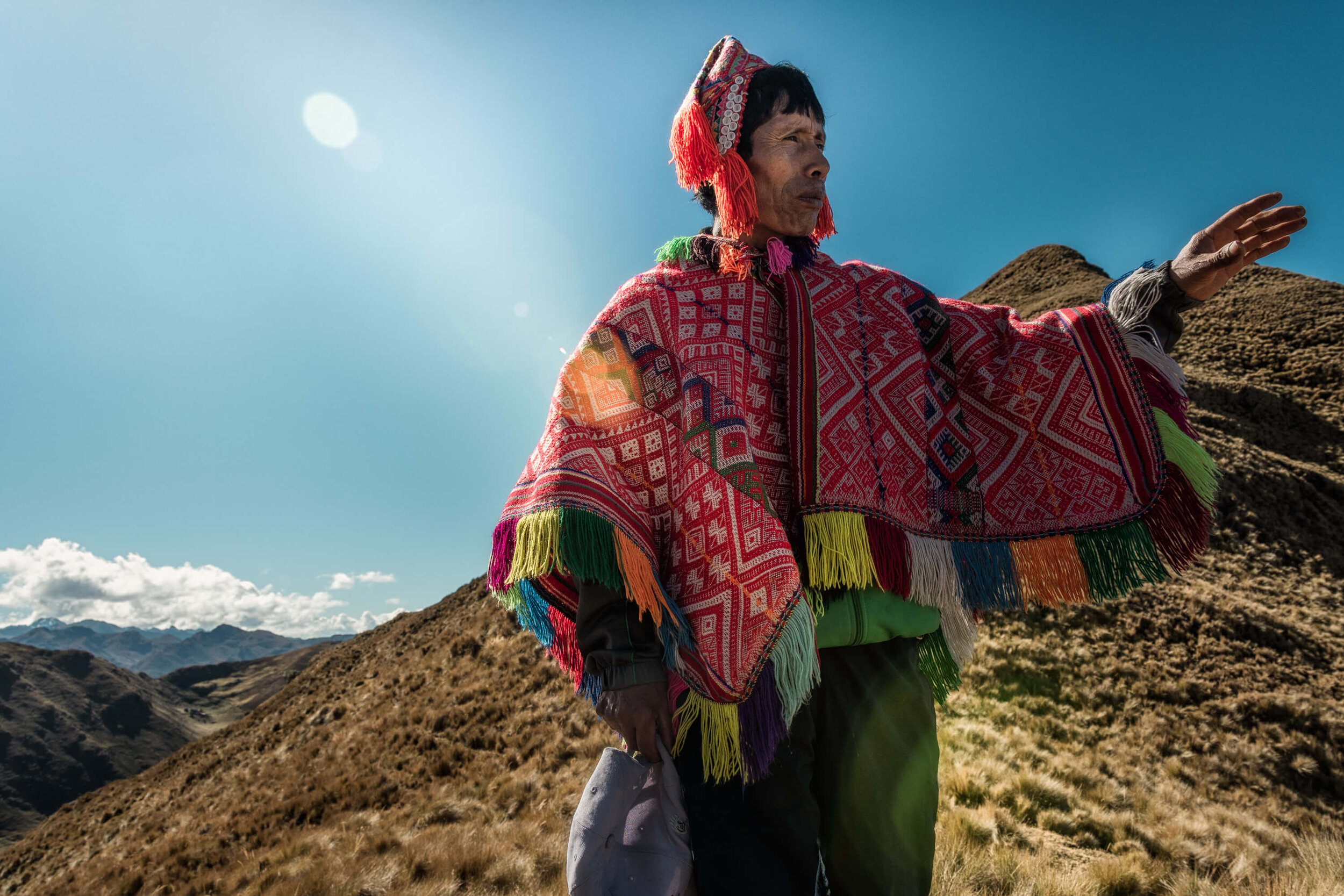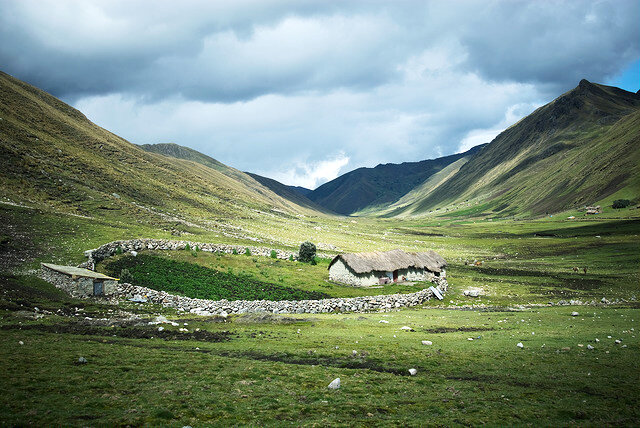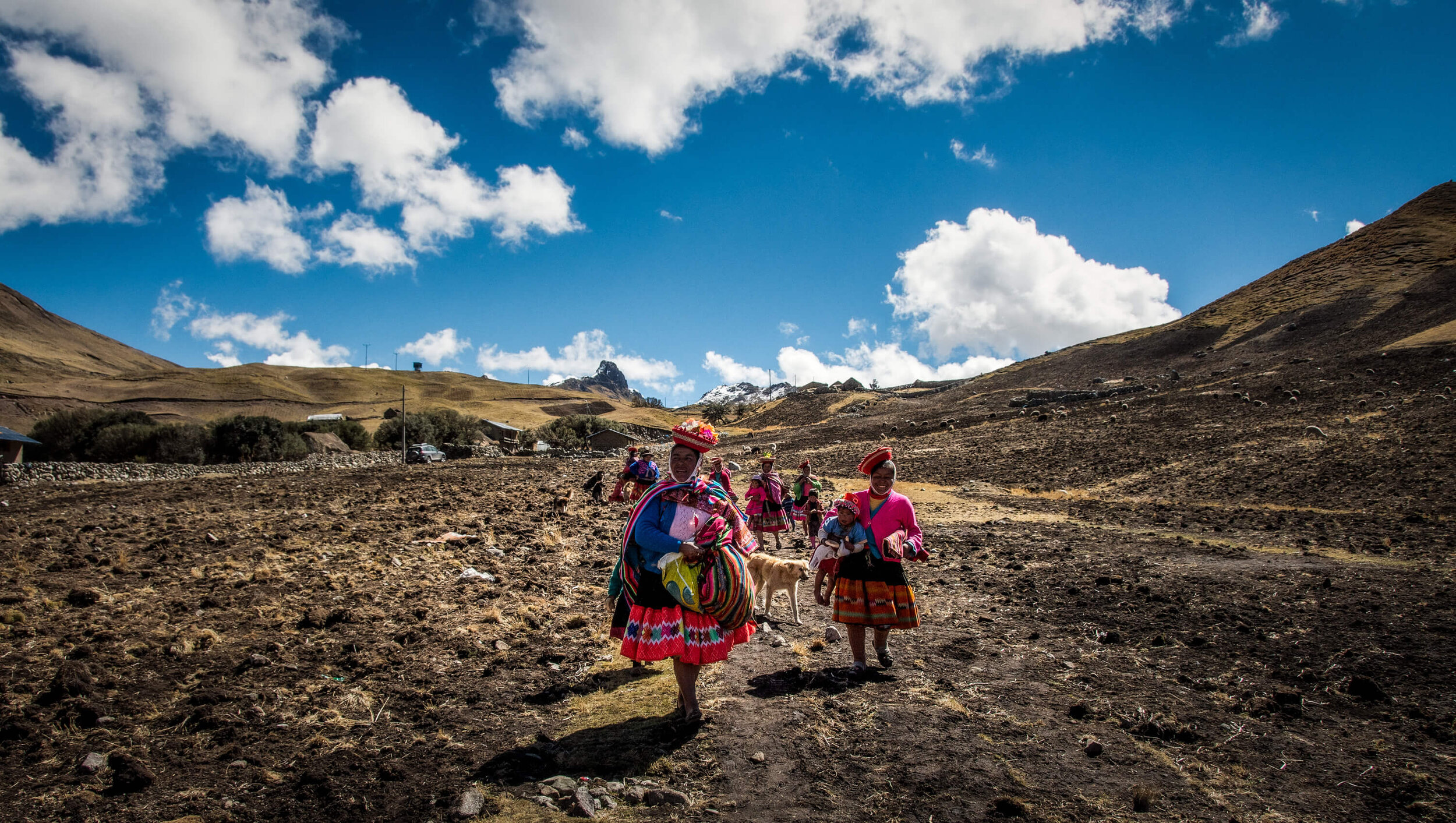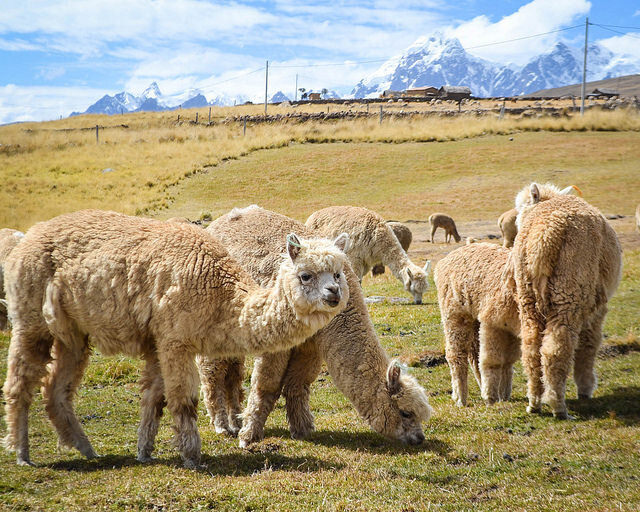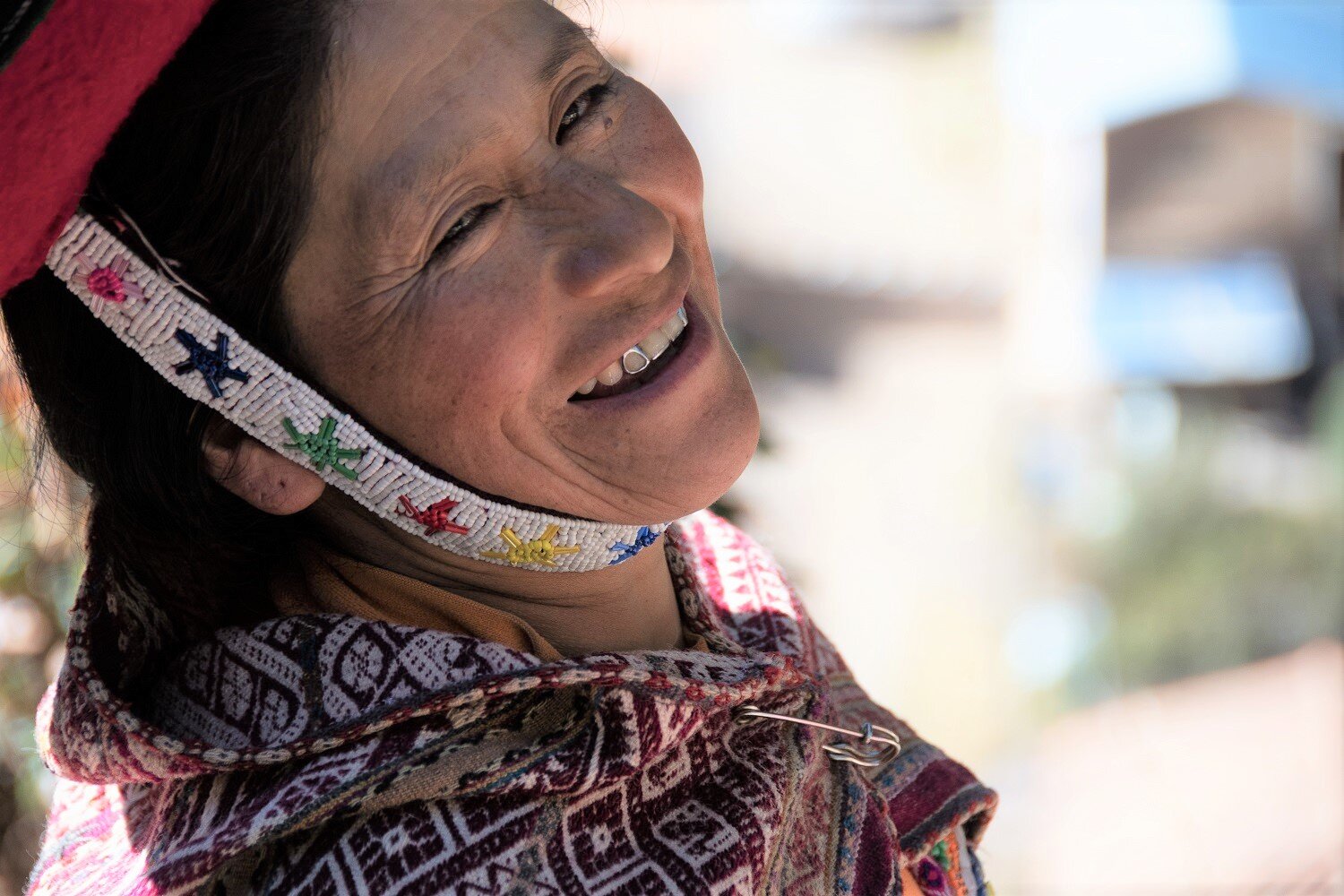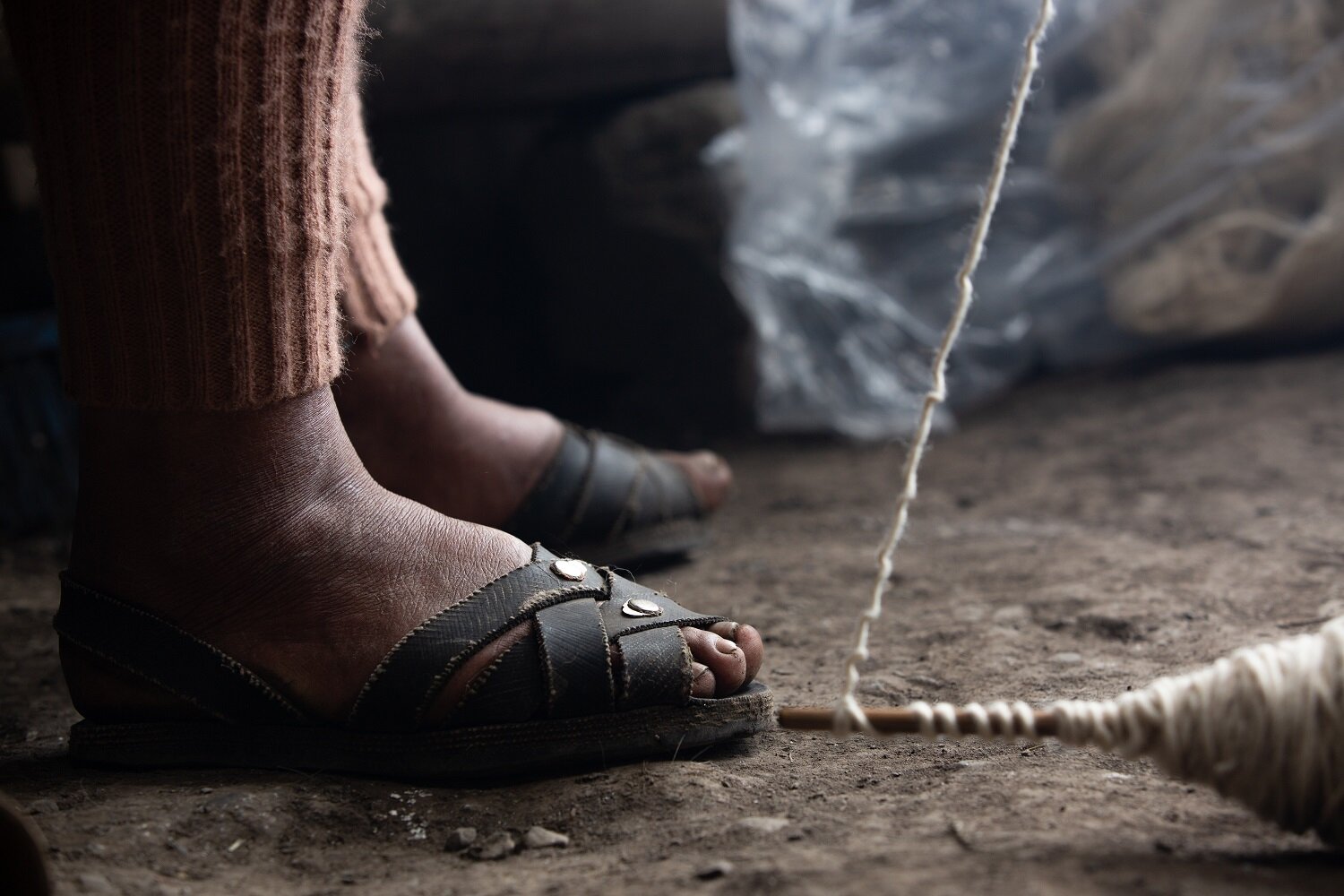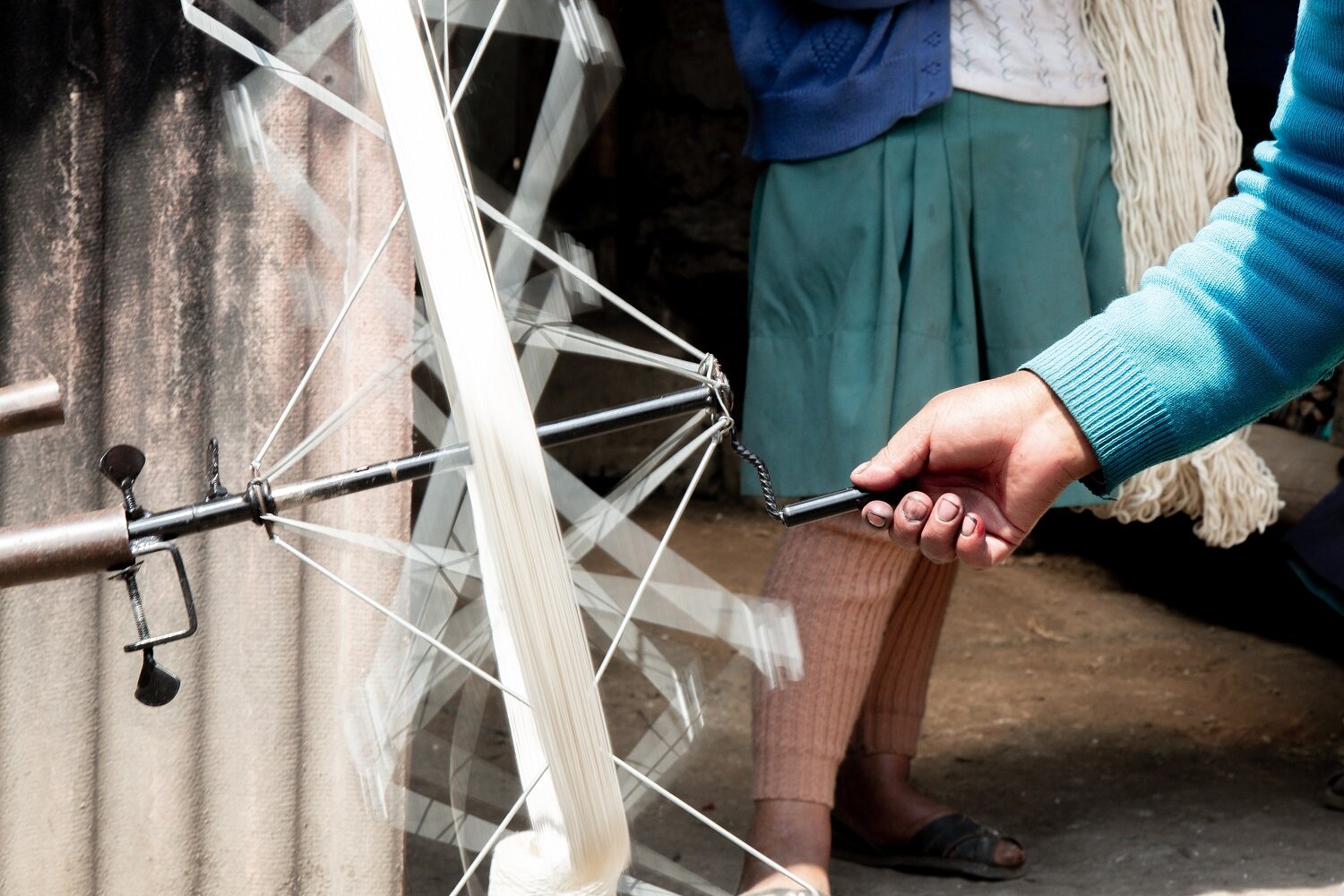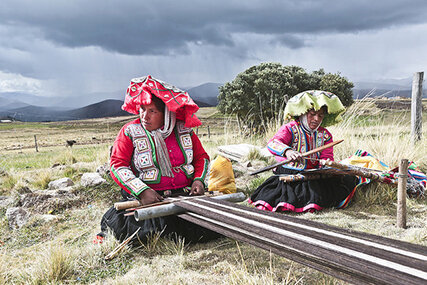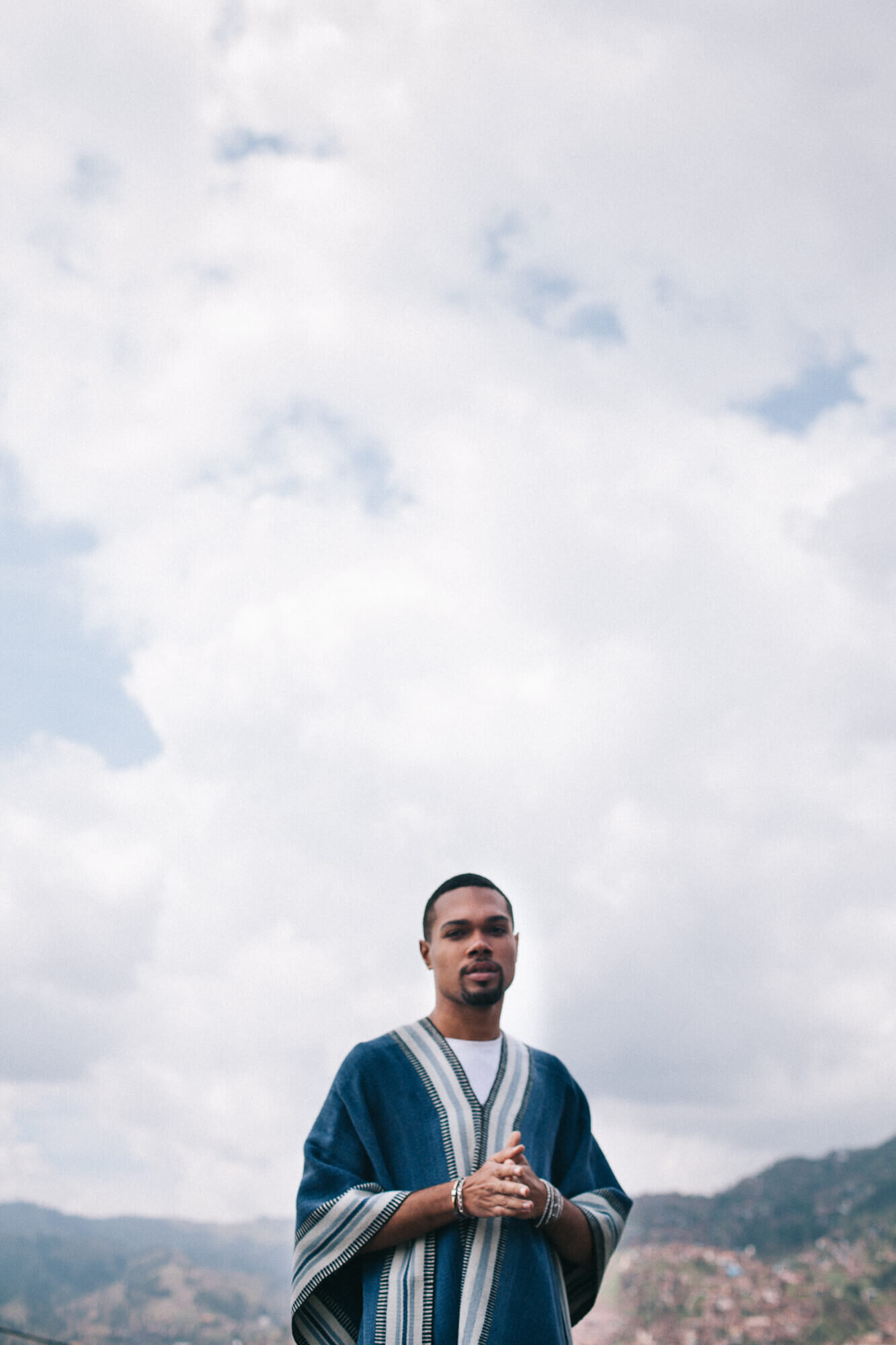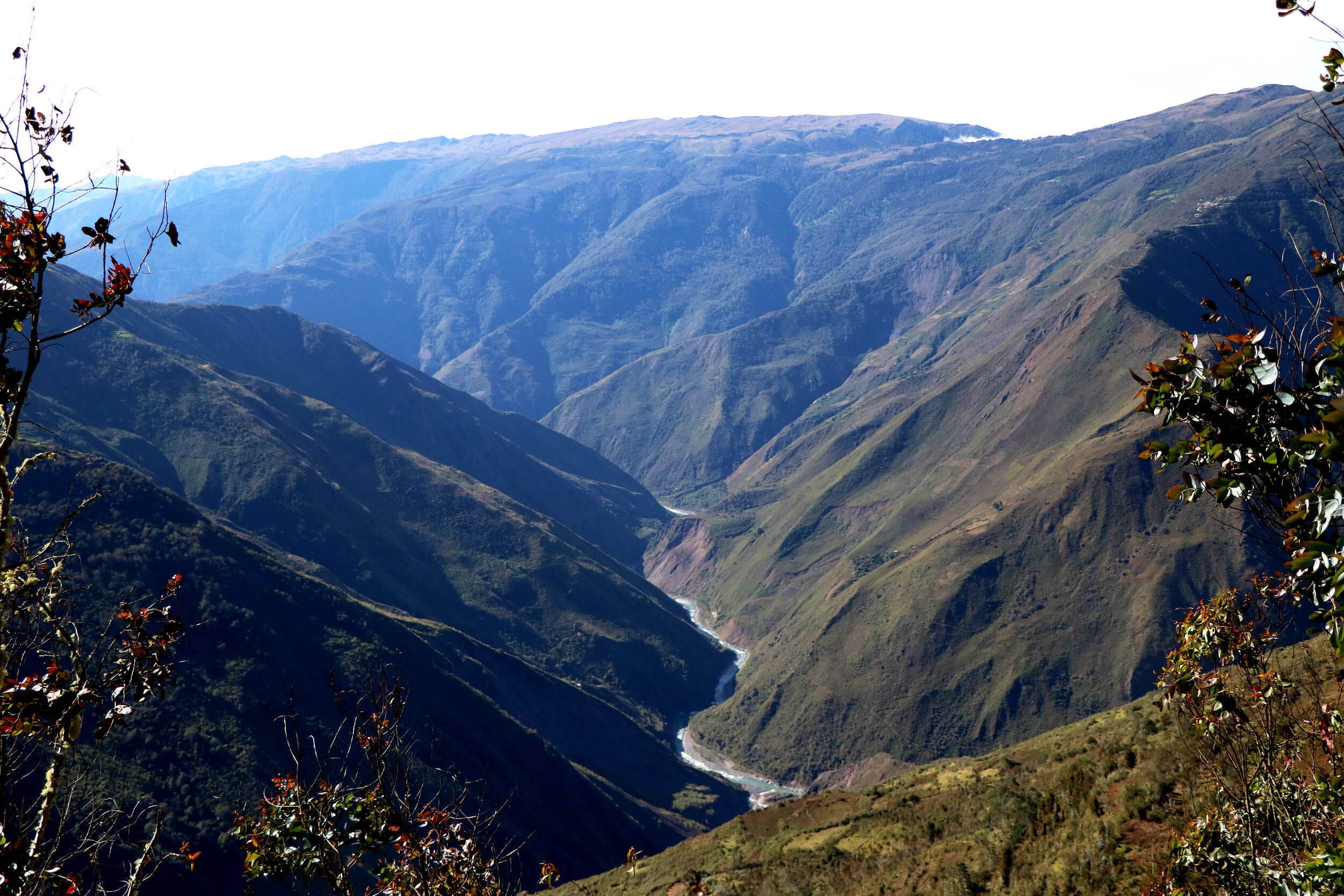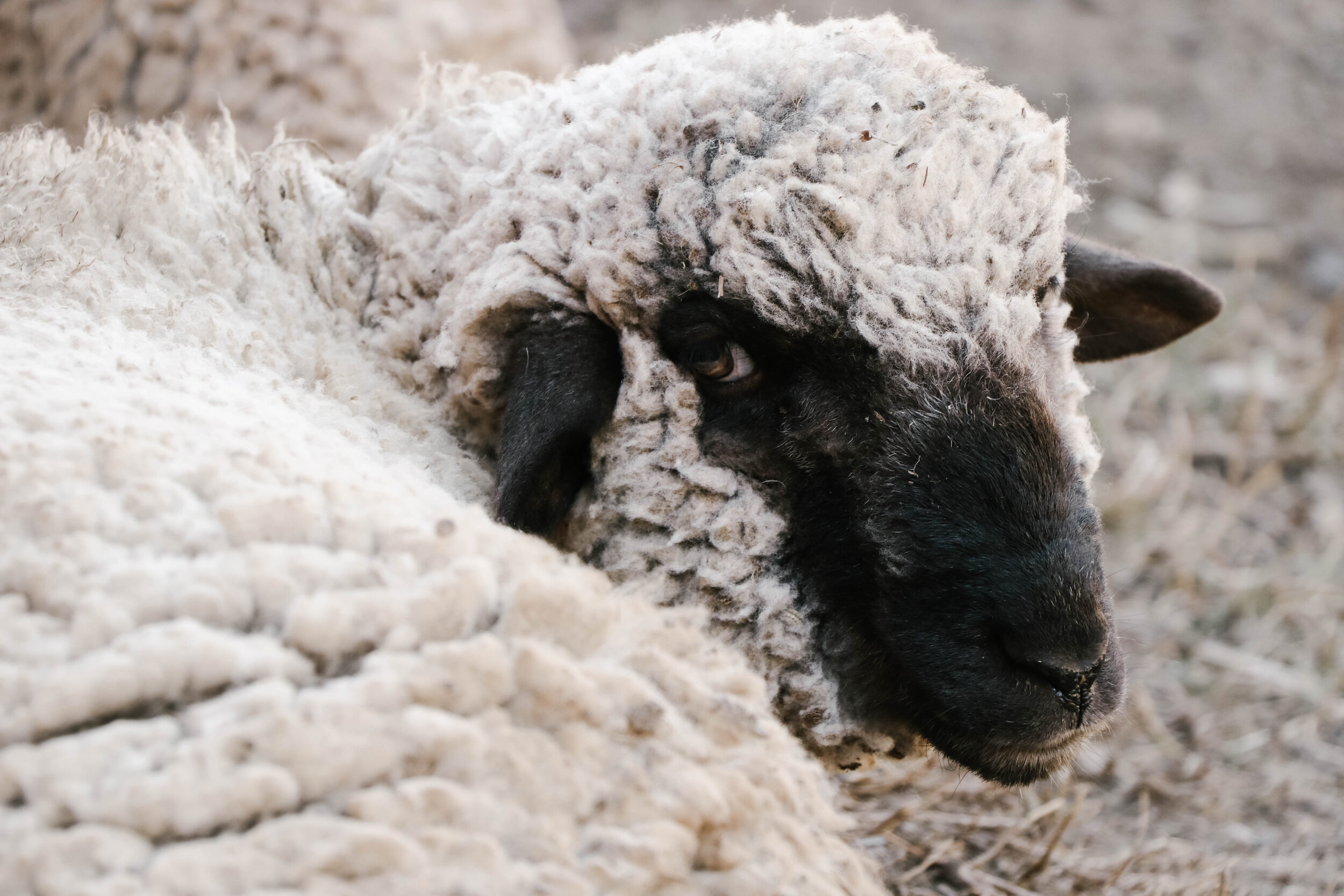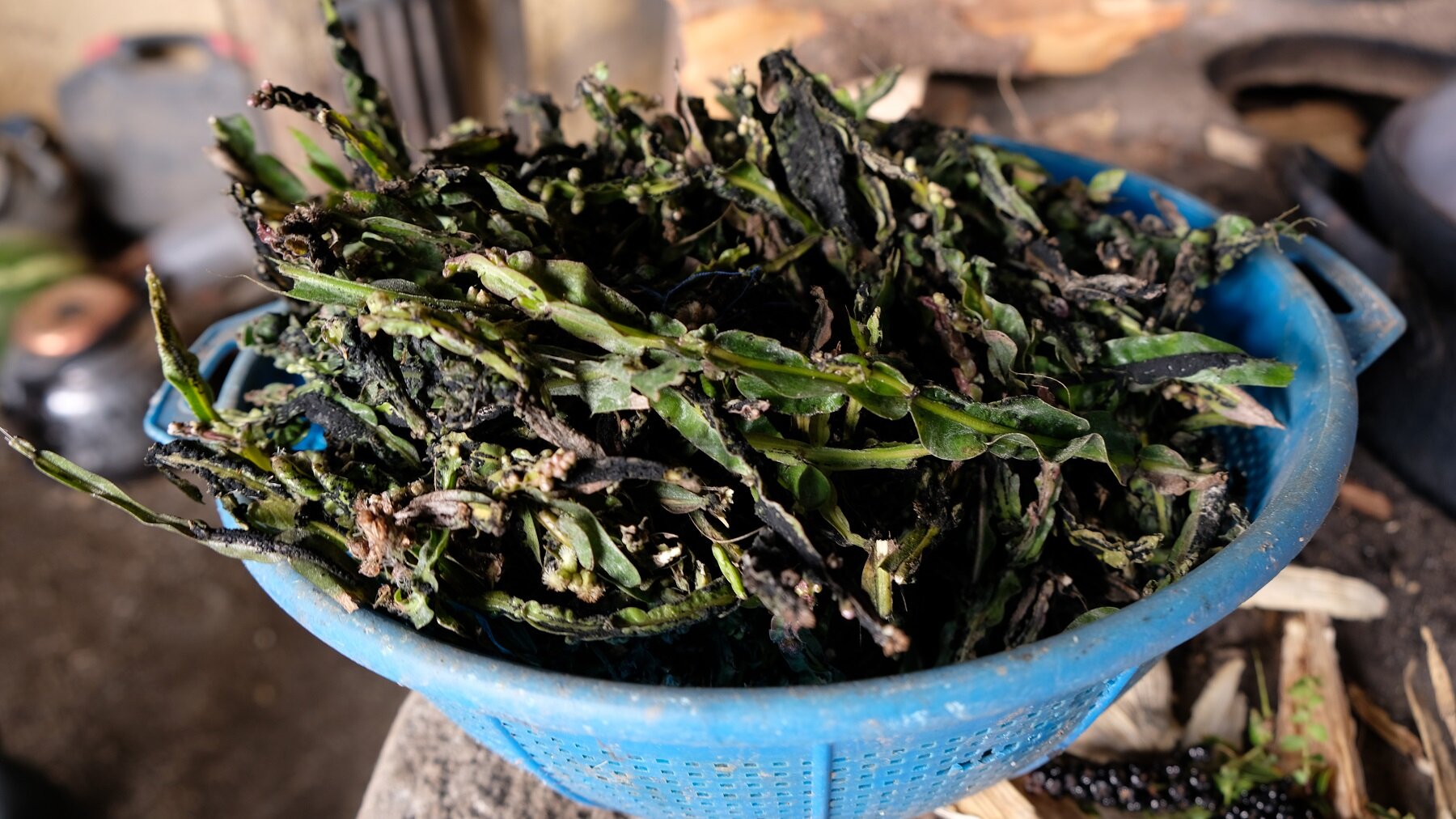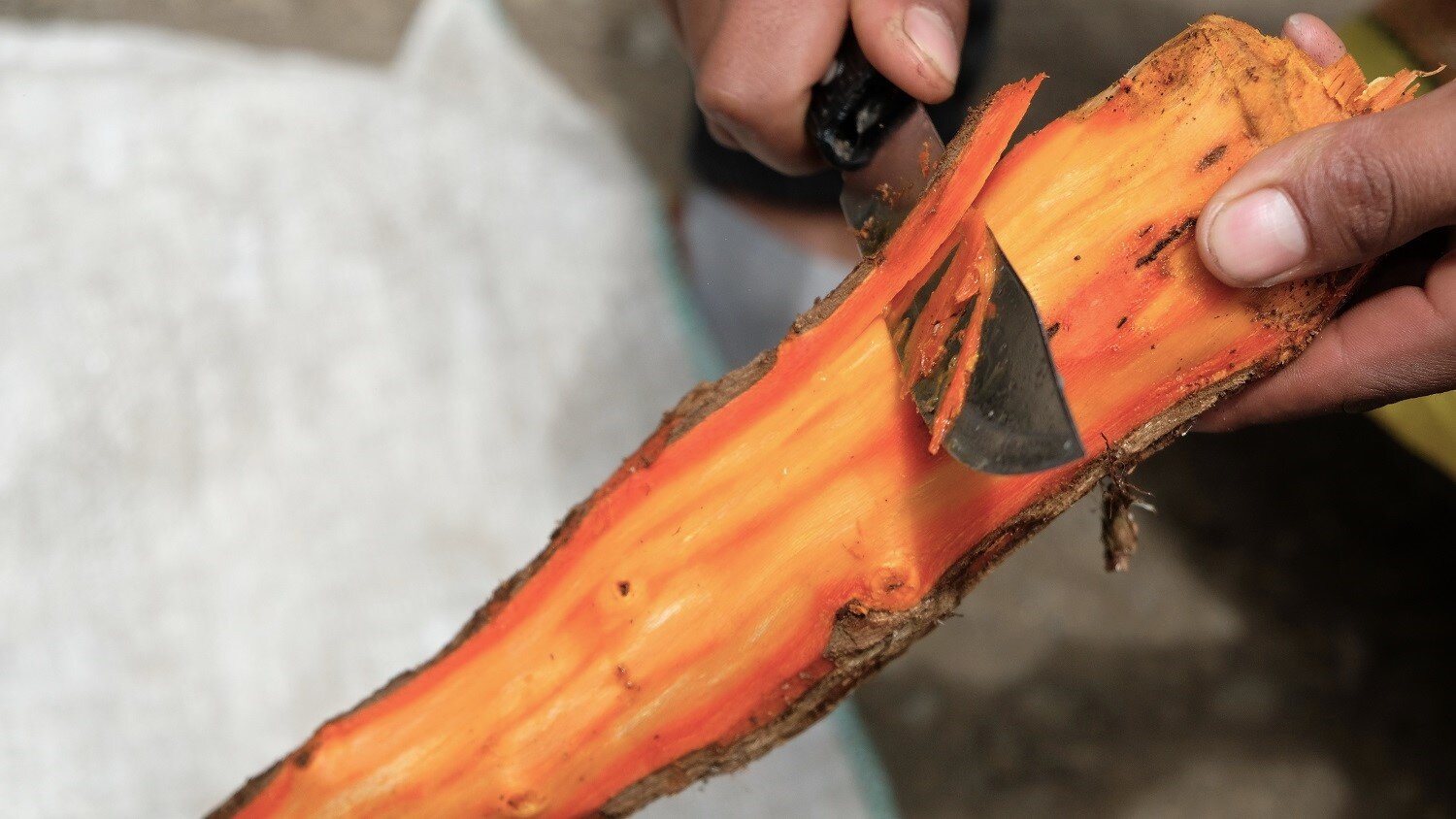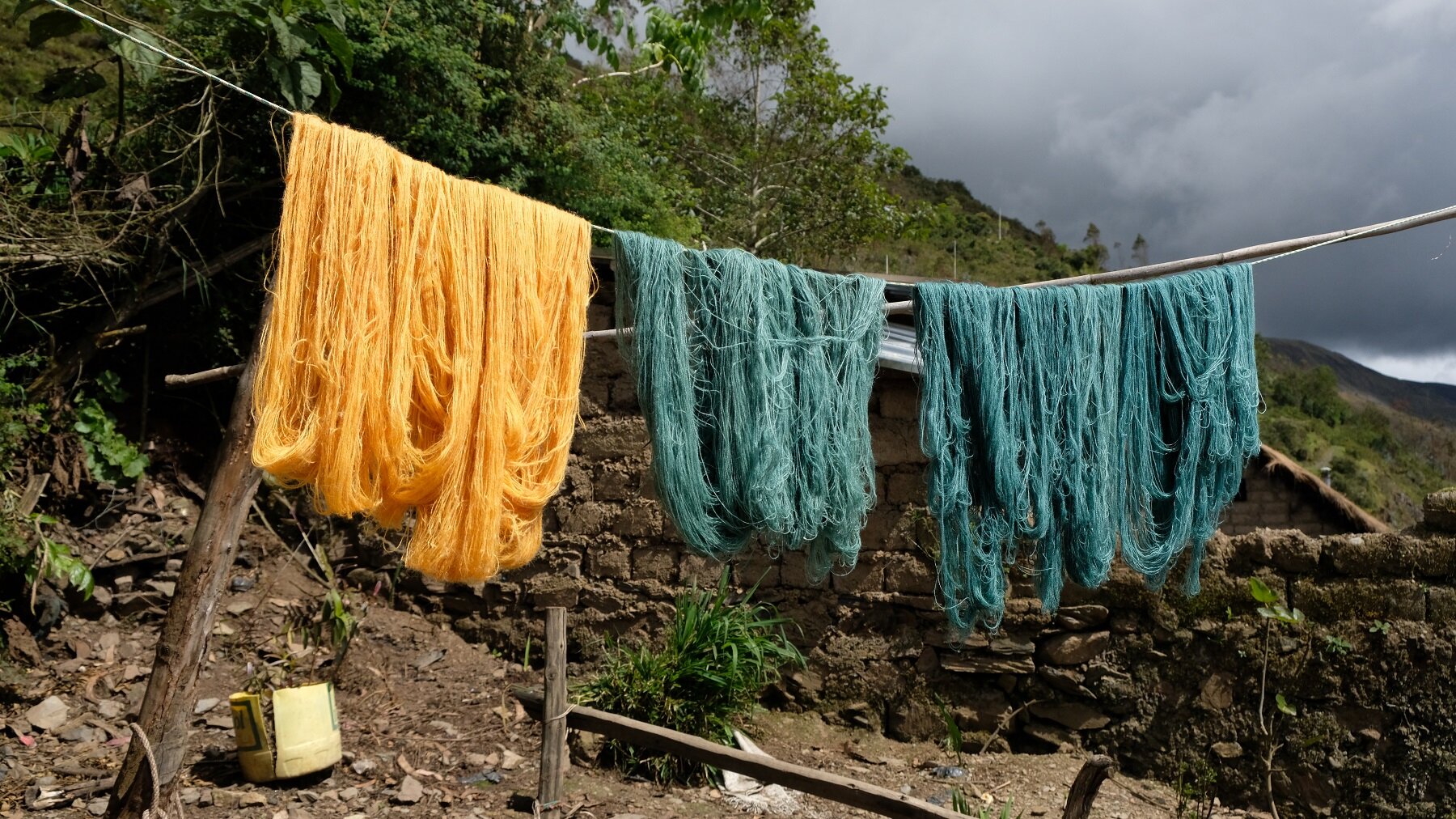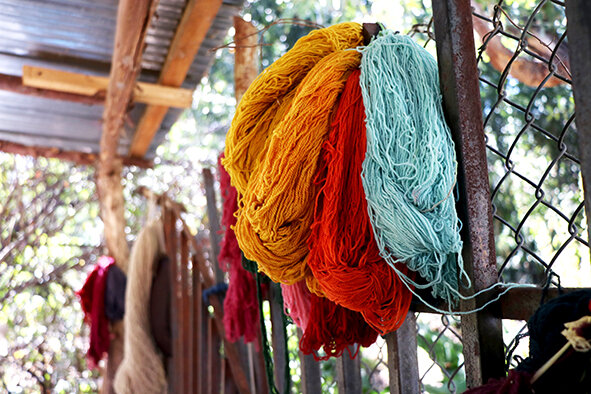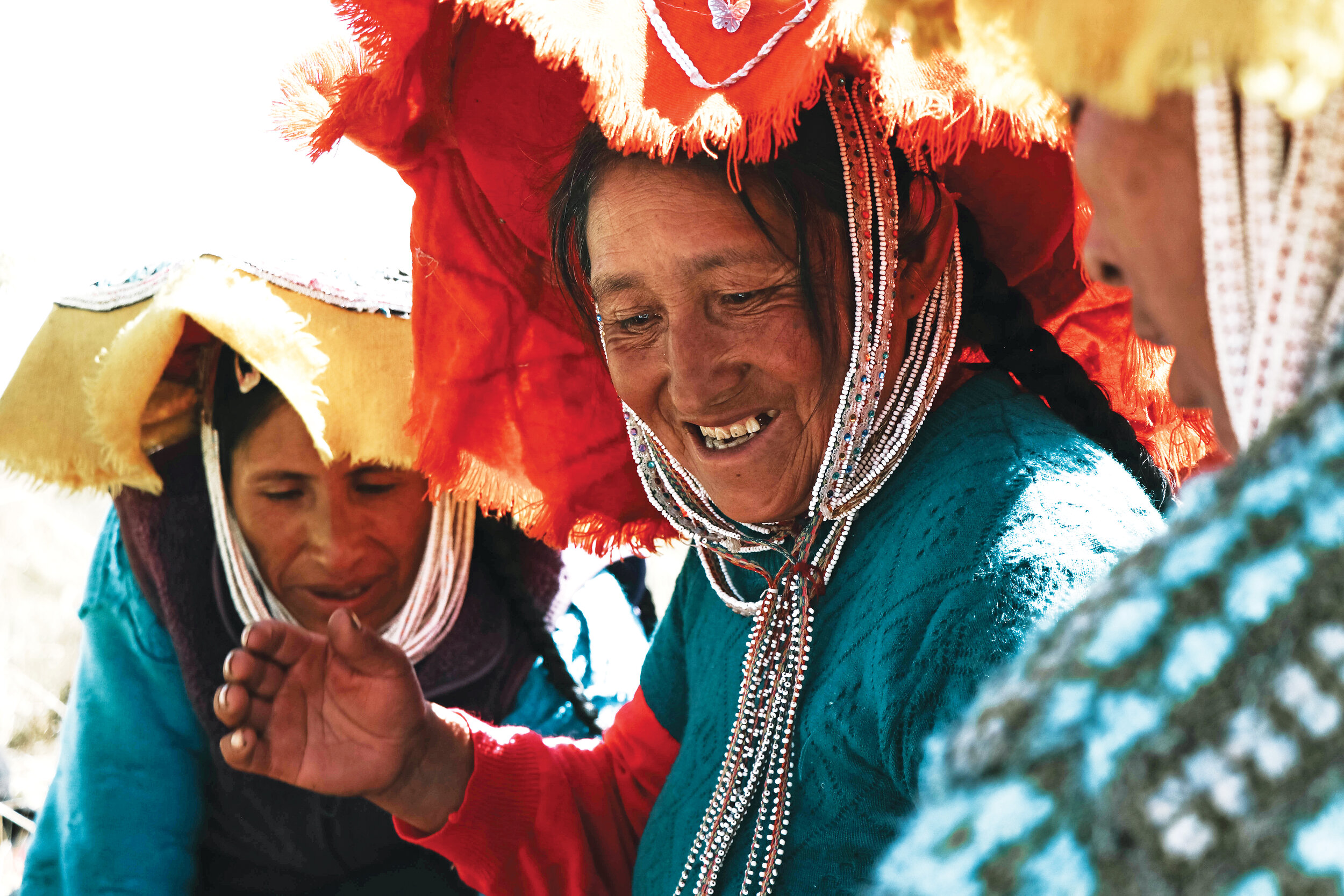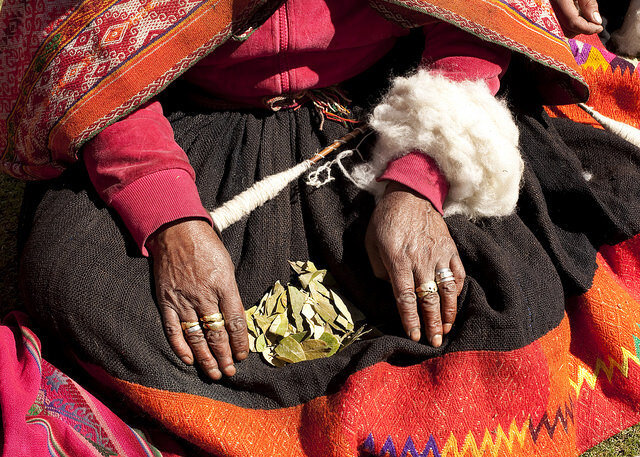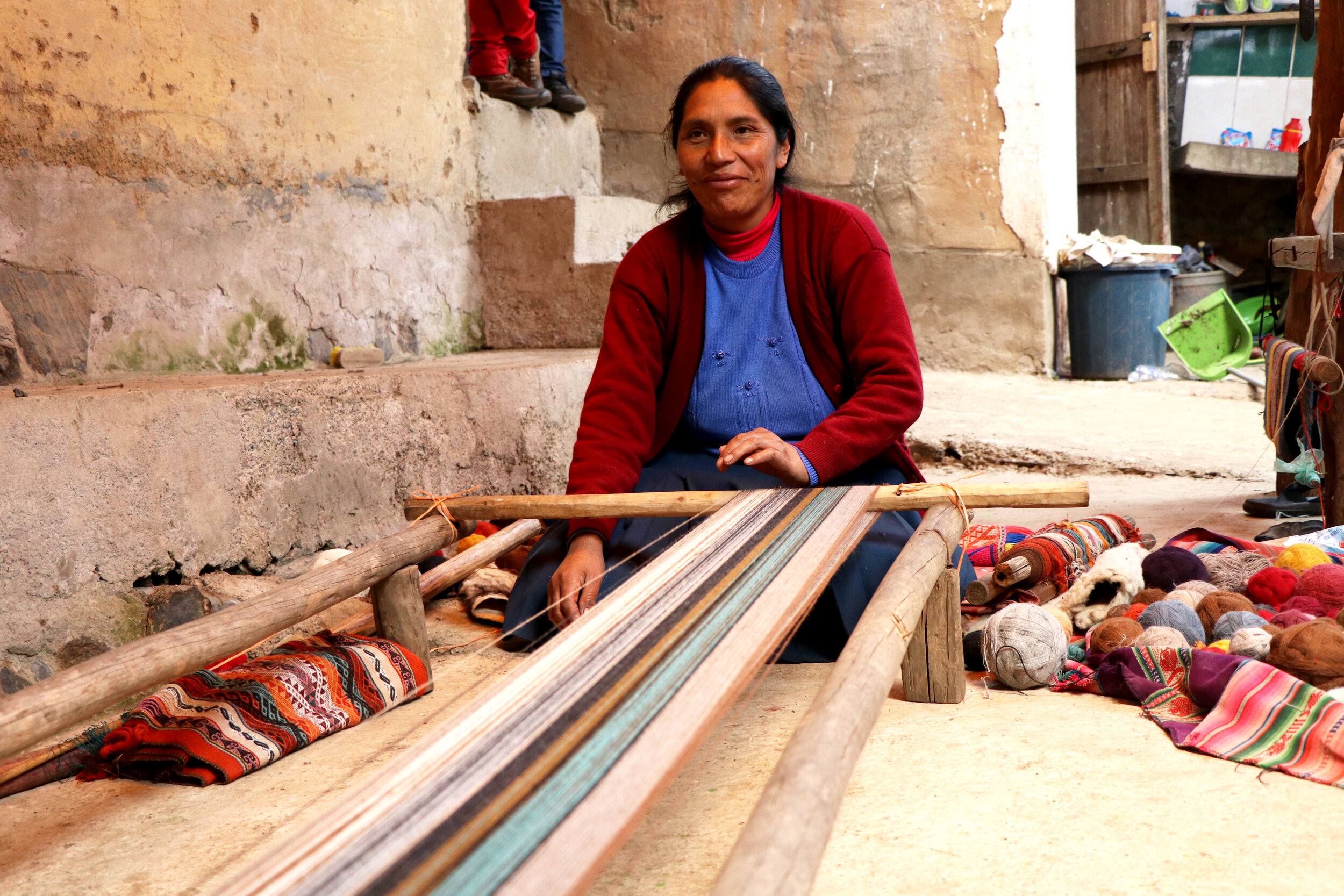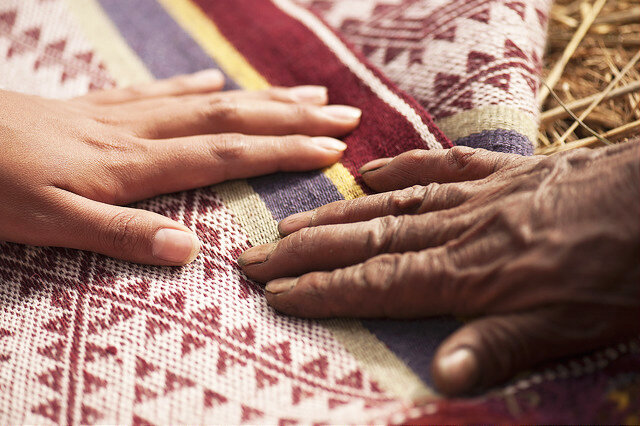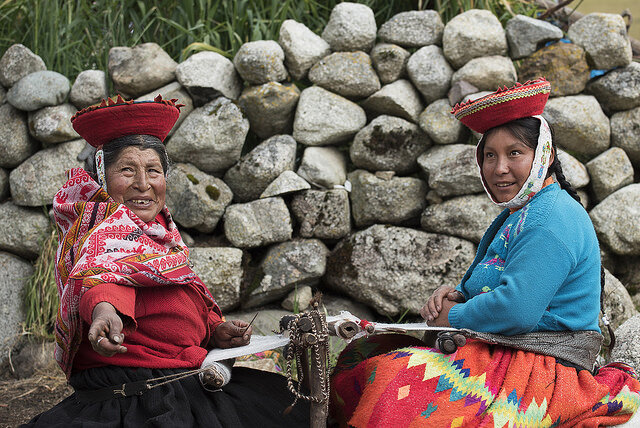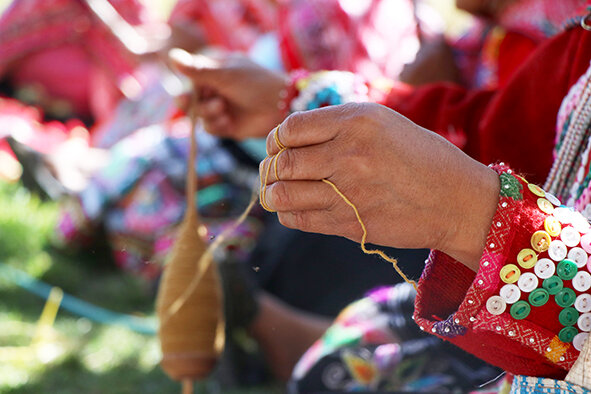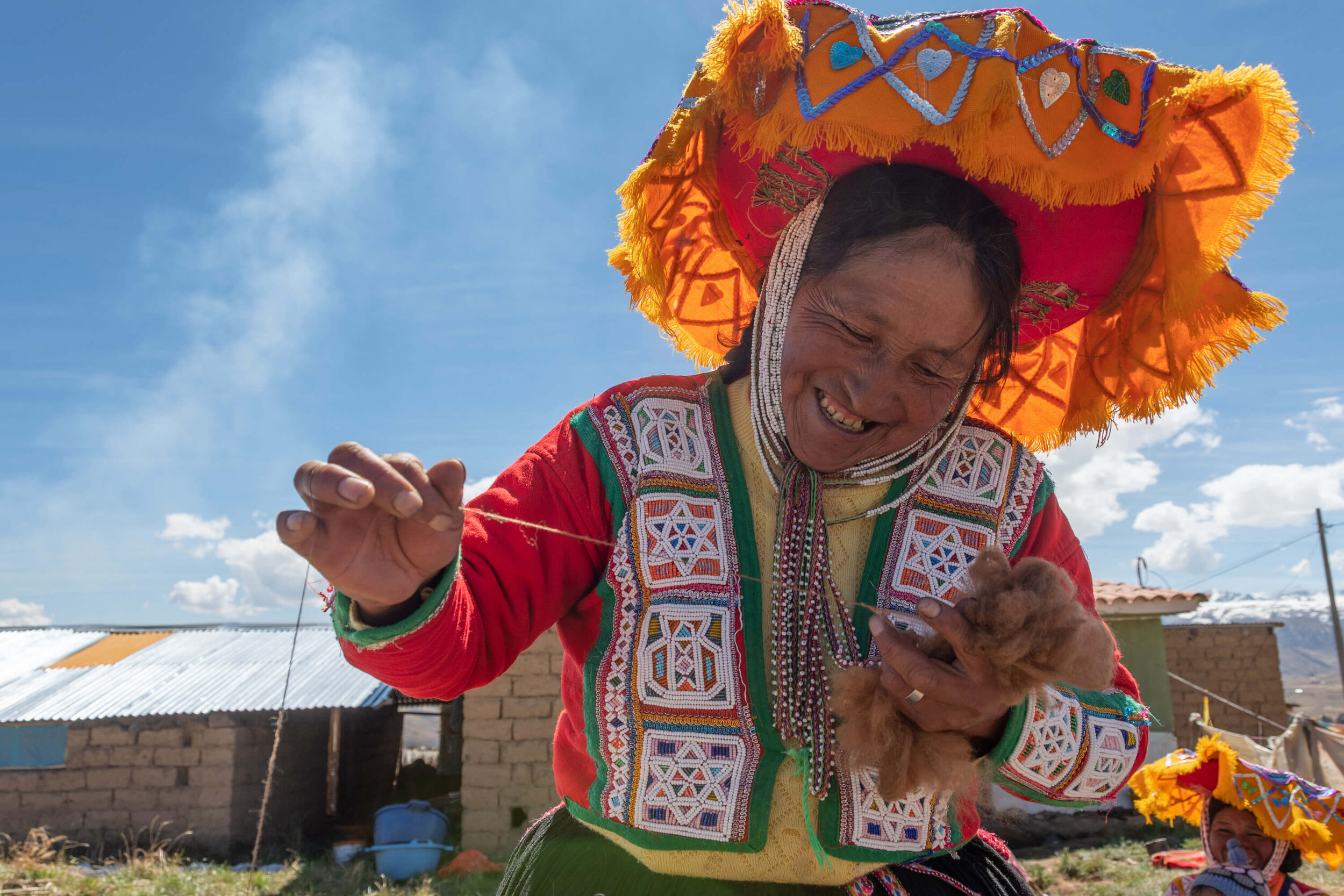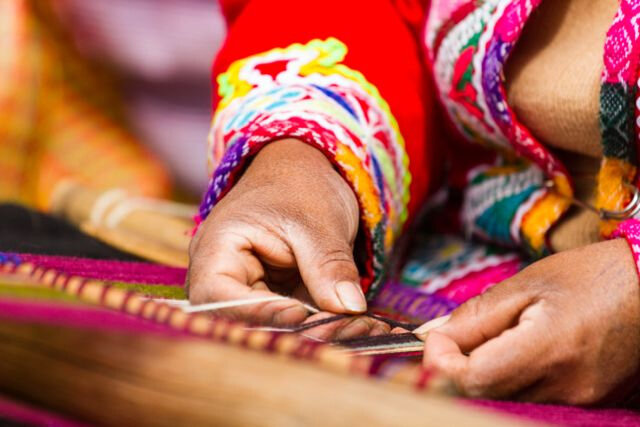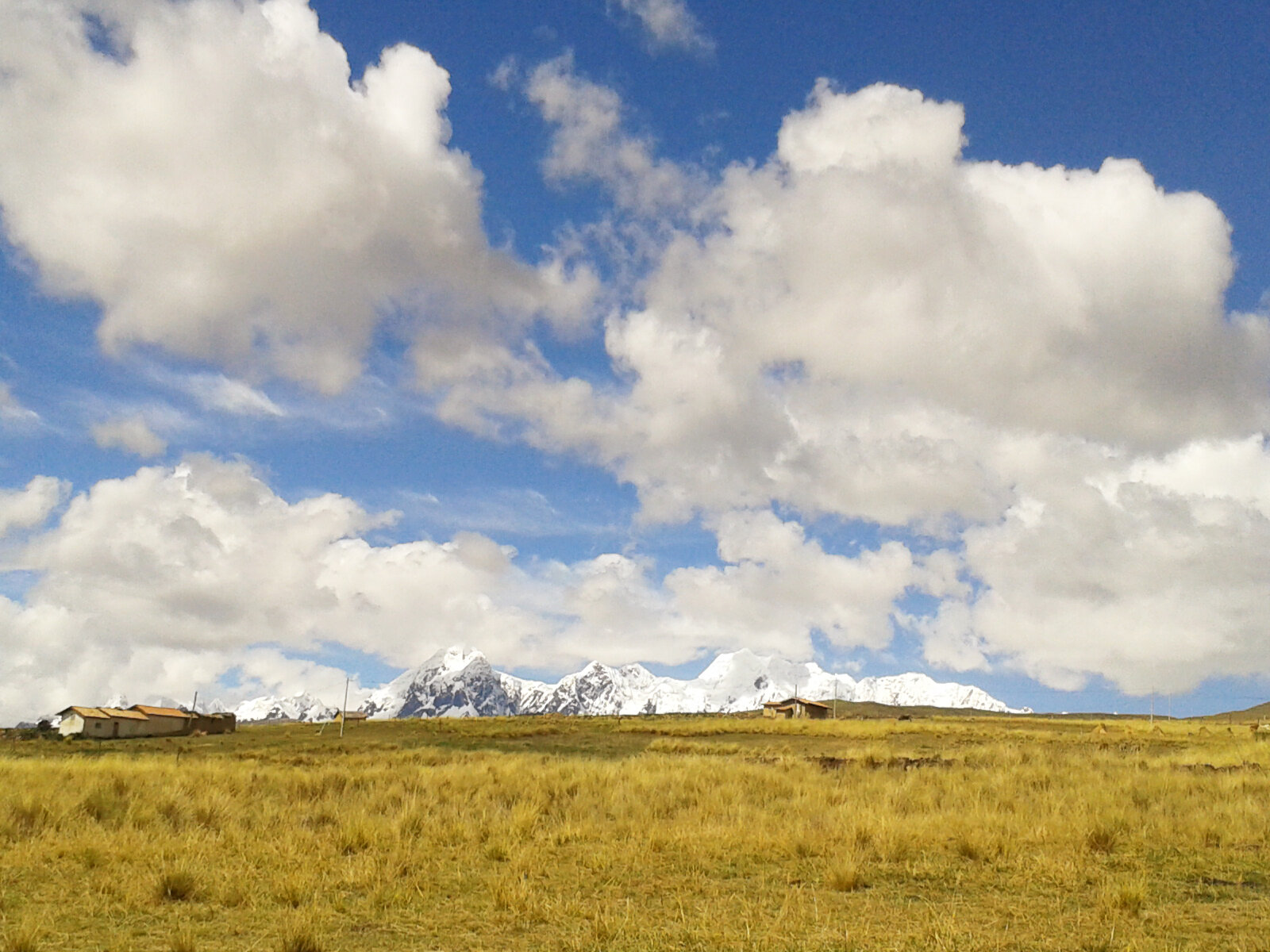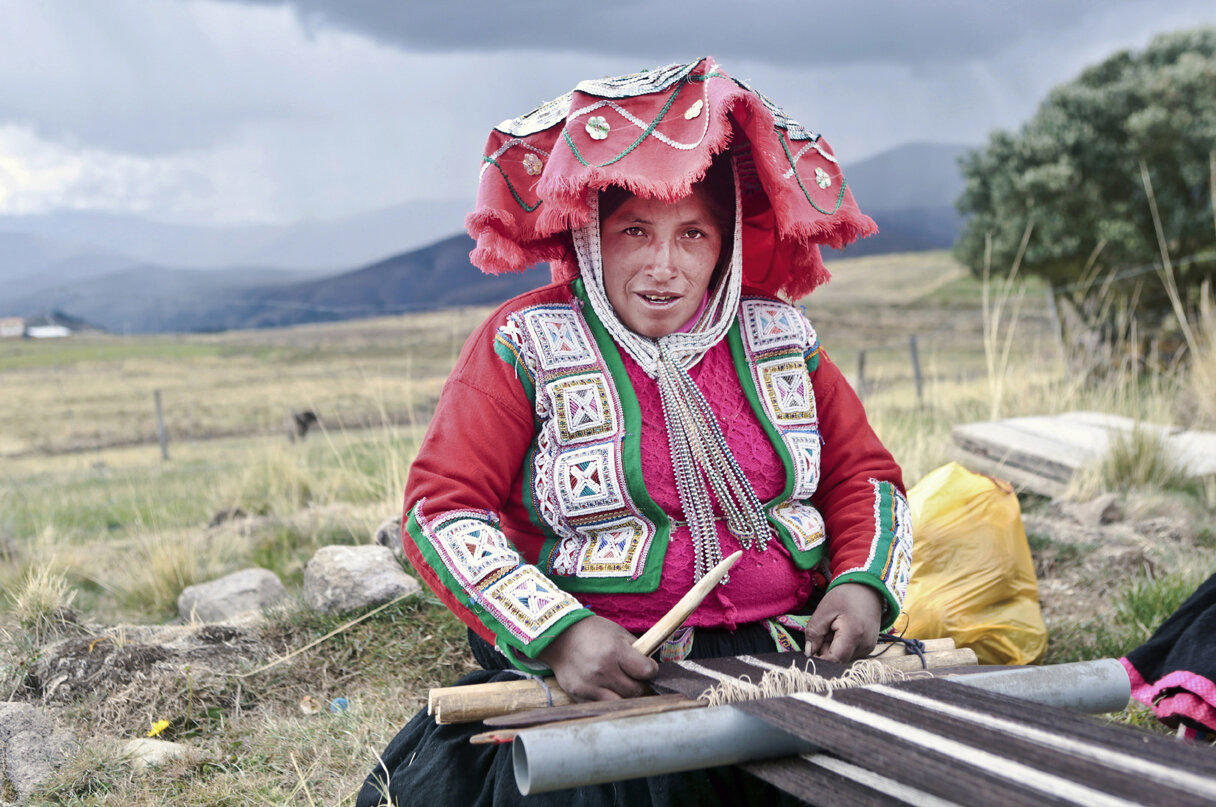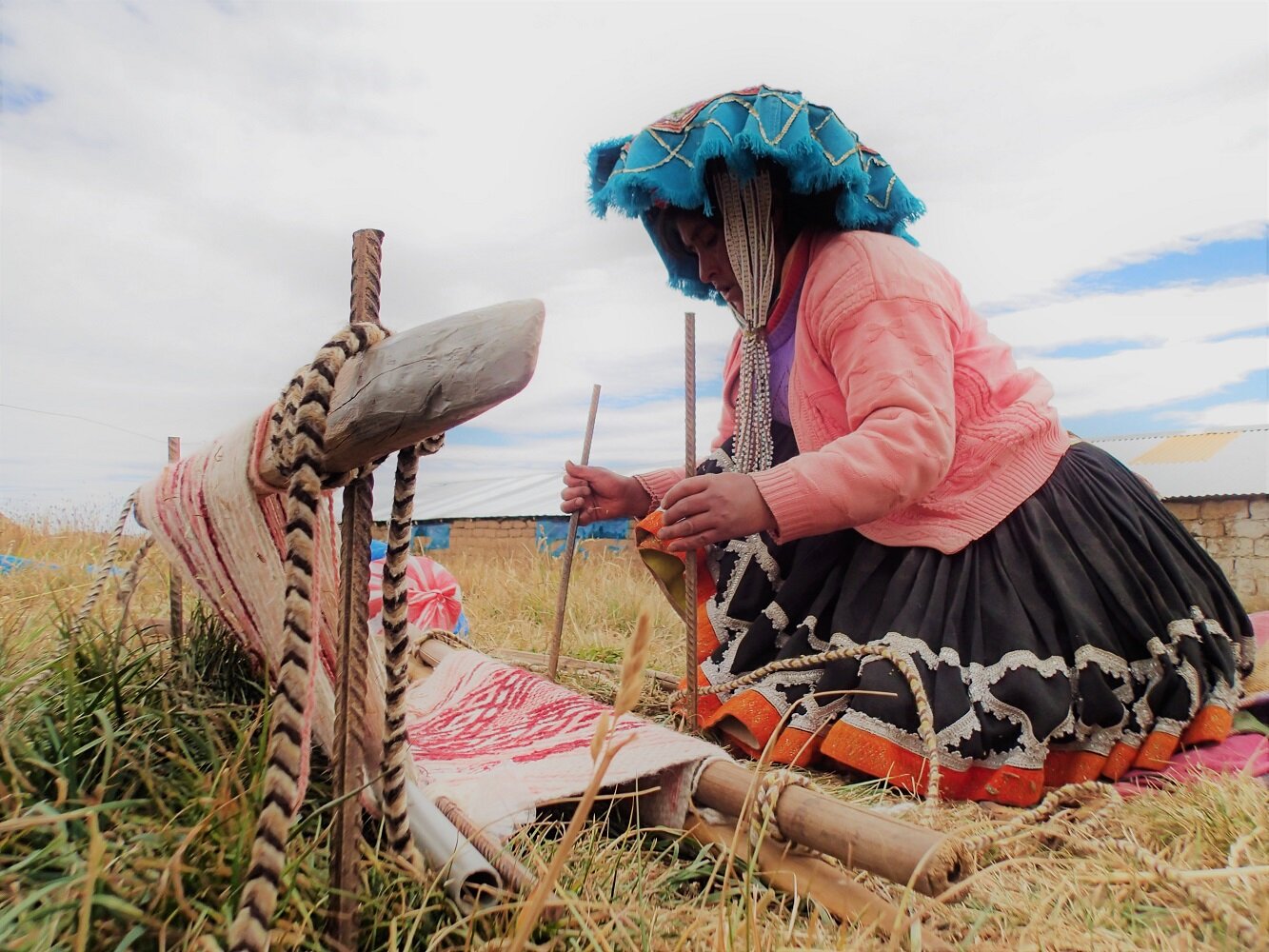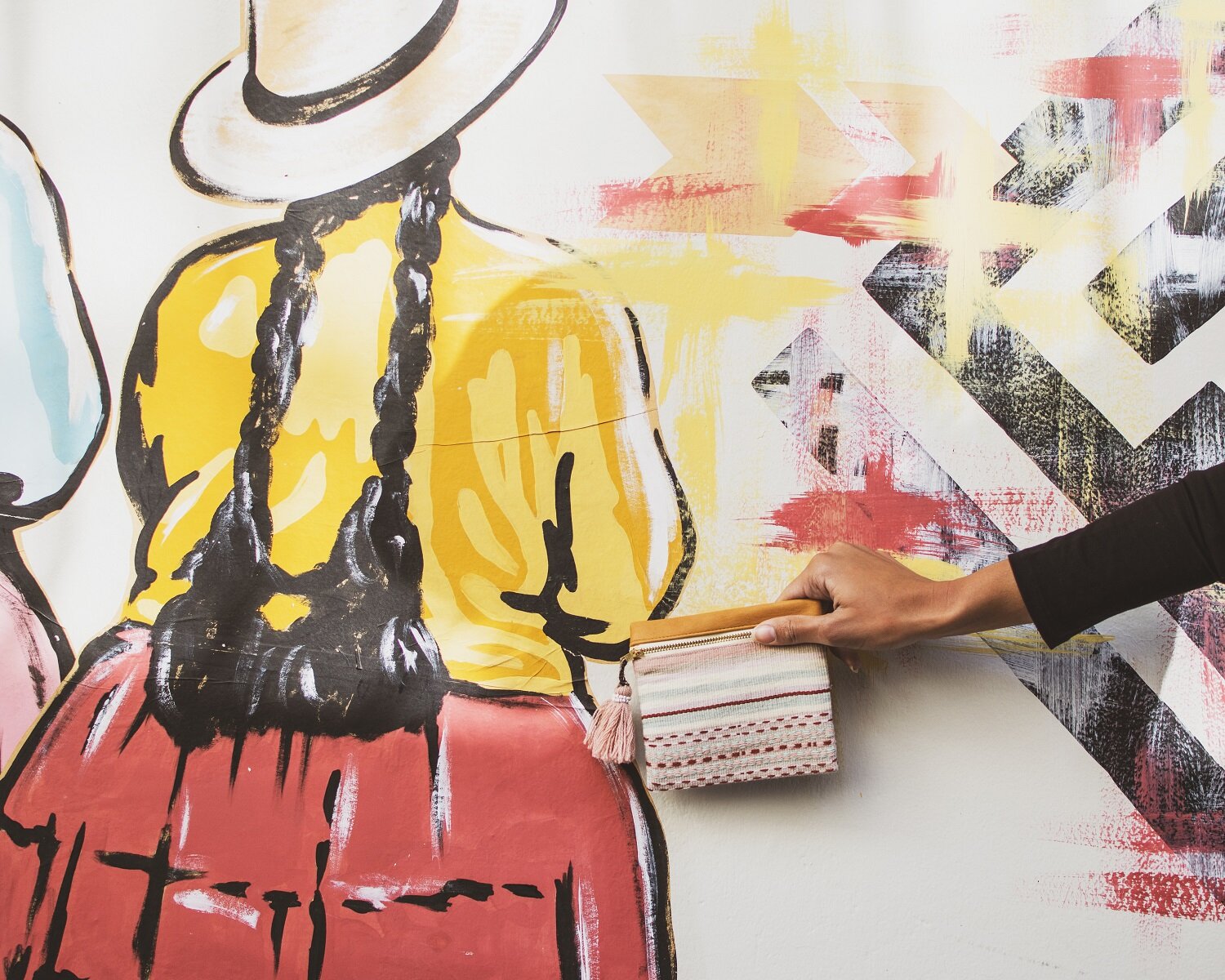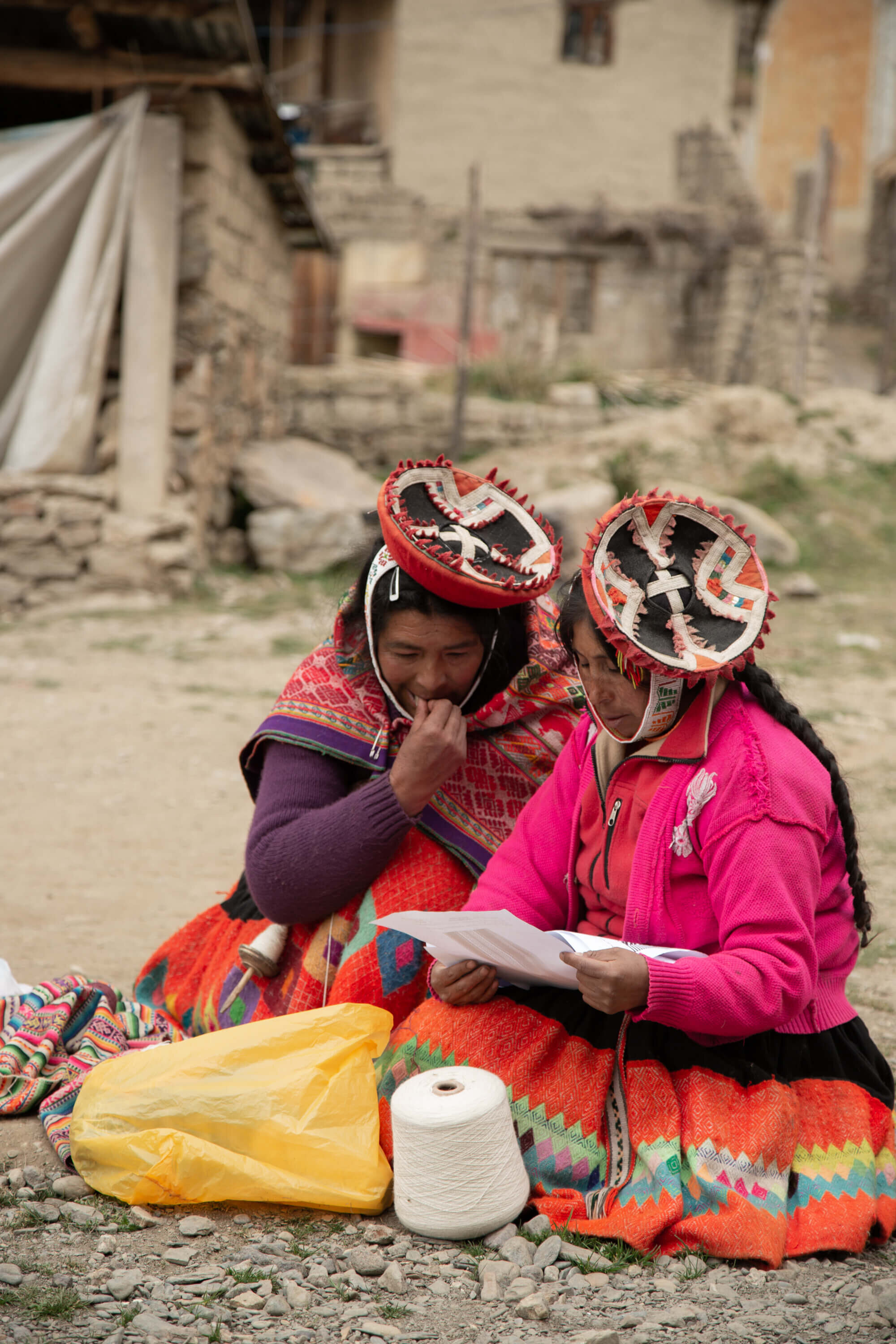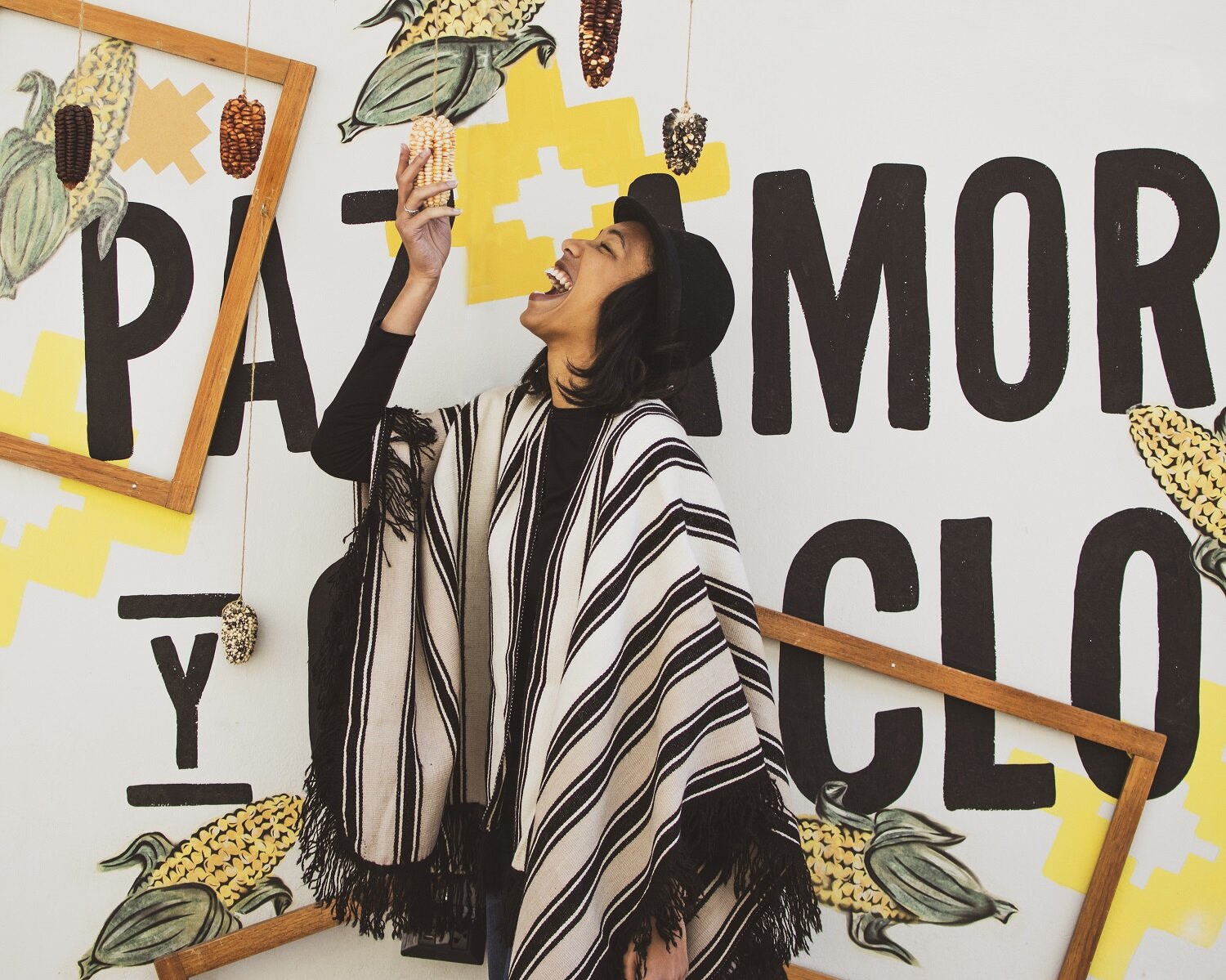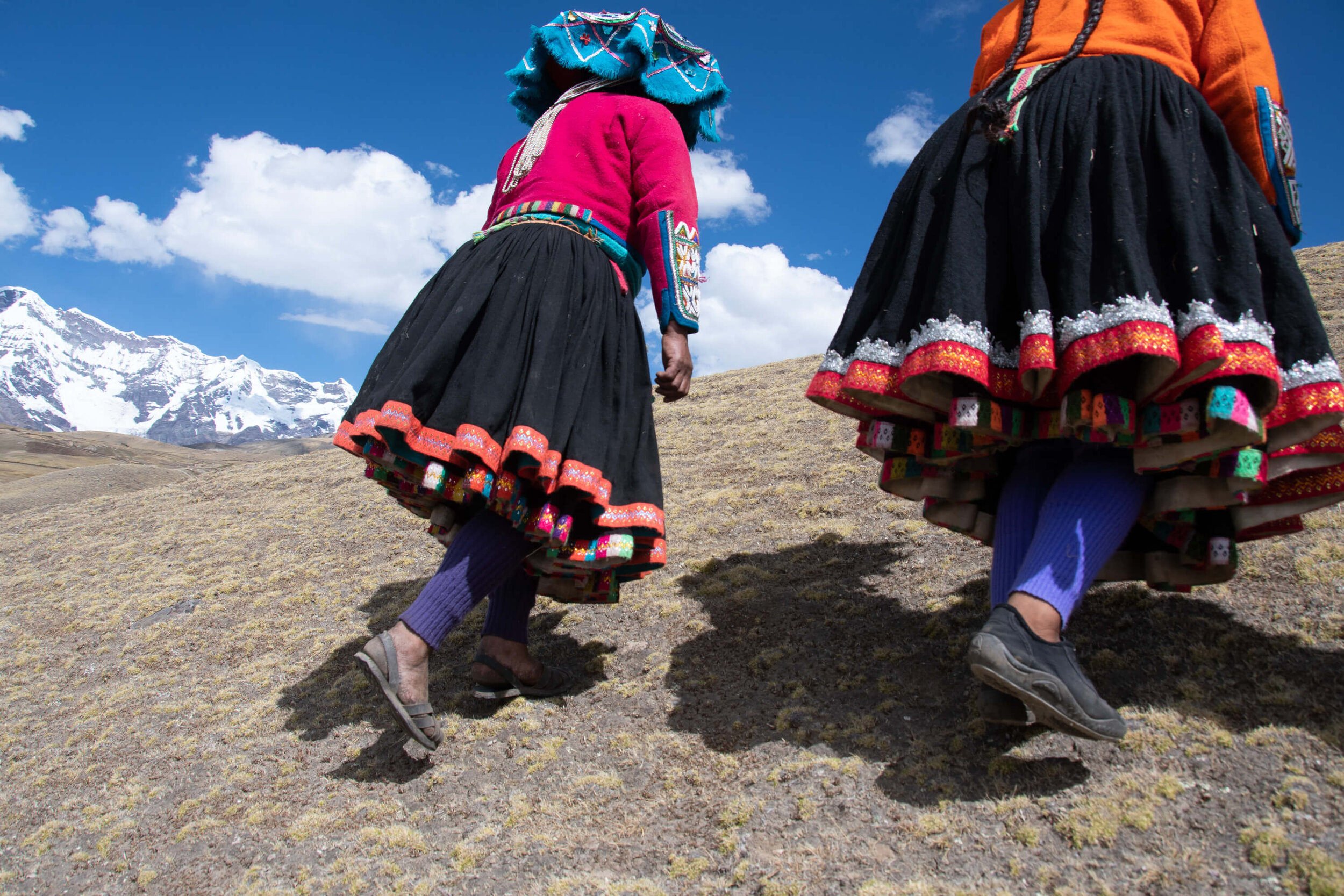SLOW MADE in Peru… Threads of Resilience
Cusco is tucked far from reach and still hums with precious existence from the ancient world. This year, (2020) has been a great test of survival for modern times. So how are these remote communities surviving right now? We reached out to Sarah Confer, the Director at Threads of Peru. A not-for-profit, social enterprise that have been working with the artisans of Cusco for a decade.
SLOW MADE THREADS OF PERU with artisan partners | DESTINATION PERU
INTERVIEW WITH SARAH CONFER, (Director, THREADS OF PERU)
Founder of Threads of Peru, Sarah Confer in Upis with Ruperta Condori Merma.
Threads of Peru is a not-for-profit social enterprise that connects the world to the unique handmade wonders of the Andes, to help empower traditional artisan craftsmanship and communities. WHEN AND HOW DID THIS COLOURFUL VISION BEGIN?
Threads of Peru was formed in 2009. The year before, Apus Peru Adventure Travel Specialists, a local travel agency in Cusco, worked with a group of design students from Halifax, Canada to create a website to promote the woven work of the women in the communities where Apus Peru operated trekking routes. This collaboration was called Project Peru. The project was so successful and inspiring that two members of the design team and the co-owners of Apus Peru joined forces to found a non-profit organisation in Cusco called Threads of Peru. Since then, Threads of Peru has continuously evolved, improving the quality and design of the textiles produced, and helping the weavers hone their skills.
WHAT IS THE DRIVING AMBITION BEHIND THREADS OF PERU?
Threads of Peru’s mission has three pillars: to strengthen cultural traditions; empower indigenous artisans; and connect global cultures.
Threads of Peru seeks to alleviate poverty and revitalise cultural traditions in rural indigenous communities by providing sustainable markets for their incredibly fine textiles. Our commitment is to breathe life once again into the incomparable value and knowledge of natural fibres, natural dyes and backstrap weaving only found in this awe-inspiring corner of the world.
By marketing the work produced by weavers in these communities, Threads of Peru is providing an opportunity for women to earn supplementary income while continuing to live a traditional lifestyle and care for their children. We dream that this will inspire young Quechua men and women to take pride in their cultural heritage and pass it along for centuries to come.
We also aim to educate the global community about the value and unique beauty of Quechua weaving as well as how to be conscious consumers. Our website, blog and social media networks are collaboratively maintained by team members who have all been deeply inspired by the Threads of Peru mission and seek to share that passion with the world. The overall mission and model of Threads of Peru is concretised in reaching global citizens and communicating the importance of socially conscious investment.
We believe in providing a more sustainable future for the textile and clothing sector, linking fashion with awareness and responsibility. We work hand in hand with artisans to create beautiful, handcrafted, natural accessories and home textiles, each piece carefully woven one at a time according to centuries of tradition. Our products foster ecological and cultural integrity, as we focus on producing unique pieces from 100% natural materials.
WHERE ARE THE ARTISANS BASED AND HOW MANY WORK WITH YOU?
We work with artisan associations in seven communities in four different regions around Cusco. These are mostly remote highland communities, located between one and four hours away from Cusco. Although these are all Quechua-speaking, indigenous Andean communities, each region has a distinct cultural dress and is known for specific weaving techniques or traditions. In total, we work with about 120 individuals, mostly women.
CUSCO IS TUCKED FAR FROM REACH AND STILL HUMS WITH PRECIOUS EXISTENCE FROM THE ANCIENT WORLD. HOW FAR IS THE CLOSEST TOWN FOR SUPPLIES AND HEALTHCARE FACILITIES? 2020 HAS BEEN BRUTAL FOR MANY. IN ONE WAY, TRAVEL BANS HAVE BEEN A BLESSING TO HELP PROTECT PLACES LIKE CUSCO. WHAT DO YOU THINK HAS HELPED KEEP ARTISAN MORALE STRONG DURING THESE UNCERTAIN TIMES?
Since the beginning of the pandemic, Cusco has been largely cut off from the rest of Peru, and the world. There have been restrictions on regional, national and international travel and shipping which has put pressure on a lot of industries. Luckily, these restrictions have not affected the production or distribution of essential services, including food and medicines. We are also lucky in that so much food is produced locally; we have not faced the same shortages or price gouging felt in other countries.
The communities where our artisans live are located between one and four hours away from Cusco itself, though there are smaller urban centres around 30 to 45 minutes from each community. These towns are their go-to source for a lot of basic supplies and healthcare.
Many of our artisan communities have wisely been even more restrictive than Cusco or the rest of the country in terms of limiting access to their communities. As a result, they have largely been able to keep the virus out, which is good because treatment options nearby are very limited for this illness.
The restrictions on mobility and the ability to engage in other economic activities has been hard for everyone, and the weavers are no exception. However, I think they are at an advantage compared to many of us who live in the city as they are used to living a self-sufficient lifestyle.
I have seen communities face hardship before – crop failures, devastating floods – and their spirit never falters. Although this crisis is lasting much longer than other crises have, I have no doubt that their reliance on traditional ways will see them through.
HOW ARE YOUR ARTISAN FAMILIES GOING NOW? HAVE YOU BEEN ABLE TO CONTINUE WORKING WITH THEM DURING THE PANDEMIC?
For the most part, no. In the early days of the pandemic, we were completely shut off from the rest of the region beyond Cusco city’s borders, and all but essential businesses were closed. As a result, we could not travel to any communities, and we could not even purchase materials like yarn to send to them. We were in touch by phone with those that we could reach, but others live in areas with no cell service. It was very nerve-wracking to not know how they were doing!
We had a reprieve in July when borders reopened and businesses started to operate again. We still wanted to limit our travel, for the safety of our team and weavers, but we did manage to purchase a batch of yarn, get it dyed in one community and send to other communities to continue with weaving projects.
Then the borders closed again, before we were able to pick up the final products. By a combination of radio communications (that is, we ask the local radio station that we know the weavers listen to, to announce a special message over the air on our behalf), personal connections, and more than a little luck, we managed to coordinate a reception of all the finished weavings in August to send to our clients.
That has been it for now, though we are hoping that over the next couple of months we will be able to arrange a few more orders to be produced, even though we likely won’t be able to visit the communities ourselves.
"The restrictions on mobility and ability to engage in other economic activities has been hard for everyone, and the weavers are no exception. However, I think they are at an advantage compared to many who live in the city as they are used to living a self-sufficient lifestyle."
Sarah Confer (Director, Threads of Peru)
HOW IMPORTANT IS THE TRADITION OF WEAVING IN PERU?
The tradition of weaving stretches back through 5,000 years of history in Peru, from the coastal cities of Paracas and Nazca to the high Andean peaks of Cusco and Ayacucho. It is an ancient practice that was once invaluable to survival and social hierarchy. Still today, backstrap weaving is an incredibly important component of identity in the high Andes, as much as traditional alpaca herding and the native Quechua language. Weaving is literally at the very core of the Quechua culture, shaping personal and regional identities, and acting as a form of inter-regional communication. Some people invest their entire sense of personal identity in their occupation as a weaver, stating that without weaving they would no longer have an identity.
Textiles are also literally a language. Quechua was traditionally an oral language, so textiles were a means of conveying thoughts and impressions about one’s surroundings, and also of recording historical events. Everything from the spin of the fibre, to the selection and placement of colours and the combination of pallays (woven symbols) themselves have a role to play in conveying meaning.
The weaving tradition also embodies a wealth of traditional knowledge, from techniques of spinning and weaving, to which plants are useful for dyeing – when and where they grow, and how to prepare them – as well as the range of symbols particular to a community and what they mean to that community. All of this knowledge is, in a way, embodied within the individual as well as the collective community, and nowhere else. If it is not passed down from one generation to the next, it will simply be forgotten.
DO YOUR ARTISANS PRODUCE A SPECIFIC WEAVING STYLE INDIGENOUS TO PERU?
Yes. While backstrap loom weaving is practiced in many countries around the world, the Andean style is unique. The elements that distinguish Andean weaving from other traditions of backstrap loom weaving include the techniques employed, the designs created, and the materials. In the Andes, weavers use sheep wool or alpaca fibre; colours are derived from locally available plants, minerals and insects; and they create designs and design combinations that are unique to the region – even, in fact, unique to the community where they live. These textiles tell an Andean story, the story of where they are from.
ARE THE COLOURS AND PATTERNS TRADITIONAL OR ARTISAN INSPIRED?
Woven designs, called pallays, are handed down generation to generation, and some of them date back to pre-Incan times.
All of the pallays used in our textiles are traditional designs. The combination of a pallay and the overall design of the product may be the artist’s own creativity or designed by us. Same with colours – we only work with natural dyes, and some textiles feature colour combinations inspired by the artisans, while others form part of a broader palette designed for a particular collection. We aim for a balance between tradition and modern design.
THE ARTISANS SHOW AN EXCEPTIONAL LEVEL OF PRIDE AND SKILL. HOW DO THEY CONTINUE WITH THIS CULTURAL TRADITION OVER GENERATIONS?
Girls – and sometimes boys – start learning the basics of the textile process from a very early age, as young as five years old. It starts with spinning, and once they master that art, they then move on to weaving simple, narrow belts. A narrow belt consists of just one pallay, and, one by one, they master as many of the core pallays as they can. Once they become more adept, they will start to weave wider textiles that incorporate more than one pallay at a time, in different combinations. And as they grow in skill, their weavings will get more and more complex until they are able to complete a full-size manta (a blanket or wrap-around dress), which is considered the pinnacle of a weaver’s ability.
The traditional way of learning is simply to watch and practice. An elder might start a weaving for the younger person, completing one full repeat of the design while the young person watches. Then, the belt is turned over to them to try to replicate the design in a second repeat – which is done by watching and counting the yarns. All the while the teacher observes and makes corrections as necessary. By the time they finish one belt, they’ve mastered that design, memorising the pattern. And then they move on to the next, steadily increasing their repertoire.
Threads of Peru is a not-for-profit social enterprise that connects the world to handmade, textile treasures of the Andes. This video shares the unique artisan culture and communities found in Peru.
AS THE FOUNDER OF THREADS OF PERU, THIS MUST ALL BE A VERY REWARDING EXPERIENCE FOR YOU. WHAT IS IT ABOUT WORKING WITH THE PERUVIAN ARTISANS THAT YOU LOVE MOST? DO YOU LIVE IN THE REGION TOO?
Working with Threads of Peru has been extremely rewarding for me over the years. Since I began in 2012, I have seen it grow and develop as our product quality improved, the number of weavers involved grew, and all the interesting projects we’ve been able to be a part of, from tourism initiatives to a BBC film.
I love everything about what we do – exploring colour stories and dreaming up new products with our designer; filling up our office with yarn and textile samples. Seeing freshly dyed yarn hanging to dry in the courtyard fills me with incredible excitement.
But my favourite thing to do is actually spend time in the communities. I don’t get to go very often, and when I do, it’s usually just a day trip. On rare occasions, we’ll spend an overnight, sometimes hiking to and from the community. I love the crisp, fresh air, the still, pastoral surroundings, and of course, spending time with the weavers, enjoying a snack of boiled potatoes and home-made cheese. Their hospitality is always so warm and welcoming, and every time I go, I am reminded about the importance of what we do, and it renews my drive to work harder to bring them more opportunities.
At the moment, I do call Cusco my home. Since around 2009, I have been splitting my time between here and Canada, where I’m from, but I made Cusco my base in 2017. Even after all these years, I never cease to be amazed at the weavers’ skill when I see them working on a new piece, and I am awe-struck at how nimbly their fingers move through the warp, dreaming up complex designs as if by magic.
WHAT DO YOU LOVE ABOUT PERU?
What don’t I love?! There’s just something in the air about this place, it’s a bit hard to put your finger on. The people are incredibly warm and generous, and the culture so vibrant. Almost every day it seems, there are groups performing traditional dances in the main square, or saints and other religious figures being paraded down the street. The landscape is breathtaking – imposing mountains towering over verdant valleys. There is a richness to life here that seems one of a kind.
TRAVEL WILL RETURN EVENTUALLY. CAN YOU SHARE ANY LOCAL TIPS FOR VISITORS TO THIS REGION?
Don’t just stick to the main attractions. Get lost walking the narrow, cobble-stoned streets of Cusco and you’re likely to stumble onto a gorgeous secret plaza, or a gem of a coffee shop. Be adventurous and take public transport into the Sacred Valley, stopping in one of the local towns for a traditional meal. One of the most enjoyable and somewhat hidden secrets of Cusco is a small brujo town about half an hour away, where you can have your fortune read in Coca leaves. My most memorable moments have been when I have ventured off the beaten path a little.
Definitely come with an open mind. Rather than experience local life with comparison to familiarity, seek the unique differences for the most authentic way to discover another way of doing things. That's the beauty of travelling to a foreign place… feeling enriched with the knowledge of the endless possibilities this world has to offer.
WHAT HAVE THE TRIALS OF 2020 AWAKENED FOR YOU?
2020 has been a brutal year, for everyone. Whatever plans we had for this year went out the window and in many ways forced us to just stop. As an organization we have faced a number of setbacks: sales dried up; with what few sales that did come through, we still had delays in delivery due to restrictions and lockdowns. We've also been unable to travel to the artisan communities to check in with their situations, or give them more project work, so production of goods also dropped.
I’ve had to learn to let go a little bit, because we are not in control right now. It’s scary, but freeing at the same time. We’ve had to dramatically change how we do things at Threads of Peru, and we’re taking the time to brainstorm what comes next. In a way, it’s good to have a break from our routine which normally sweeps us up and keeps us from thinking beyond the day-to-day.
SHIBUI & Co. would like to thank Threads of Peru and their artisan partners for sharing their beautiful story with us.

